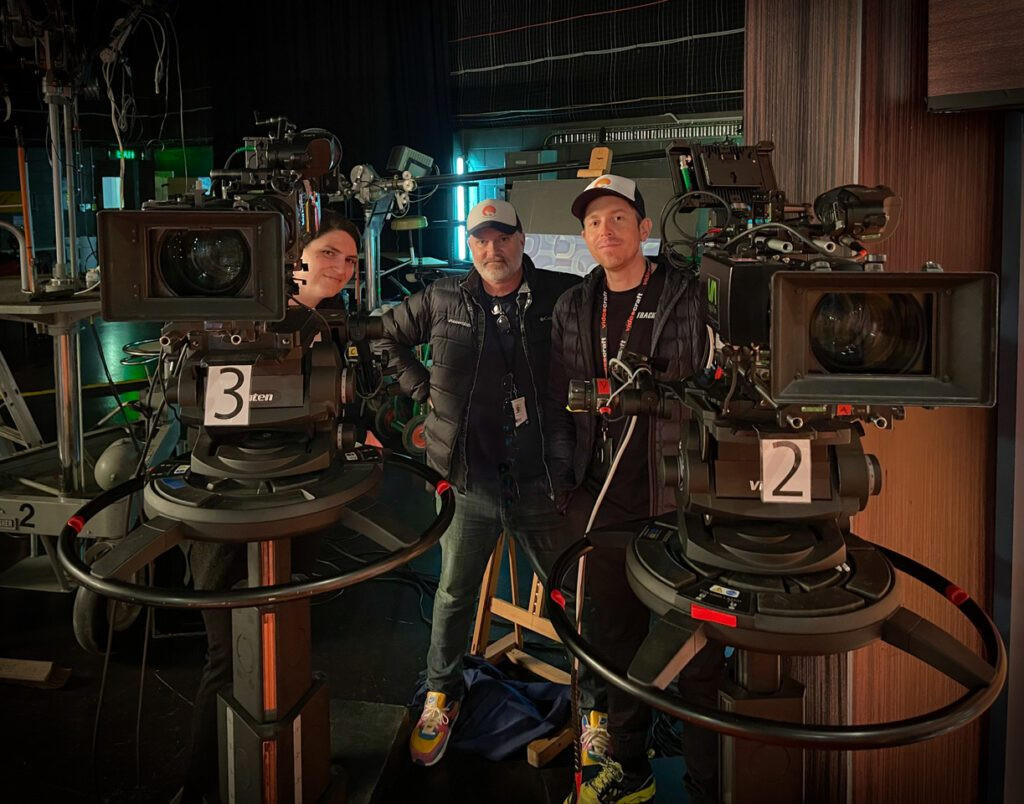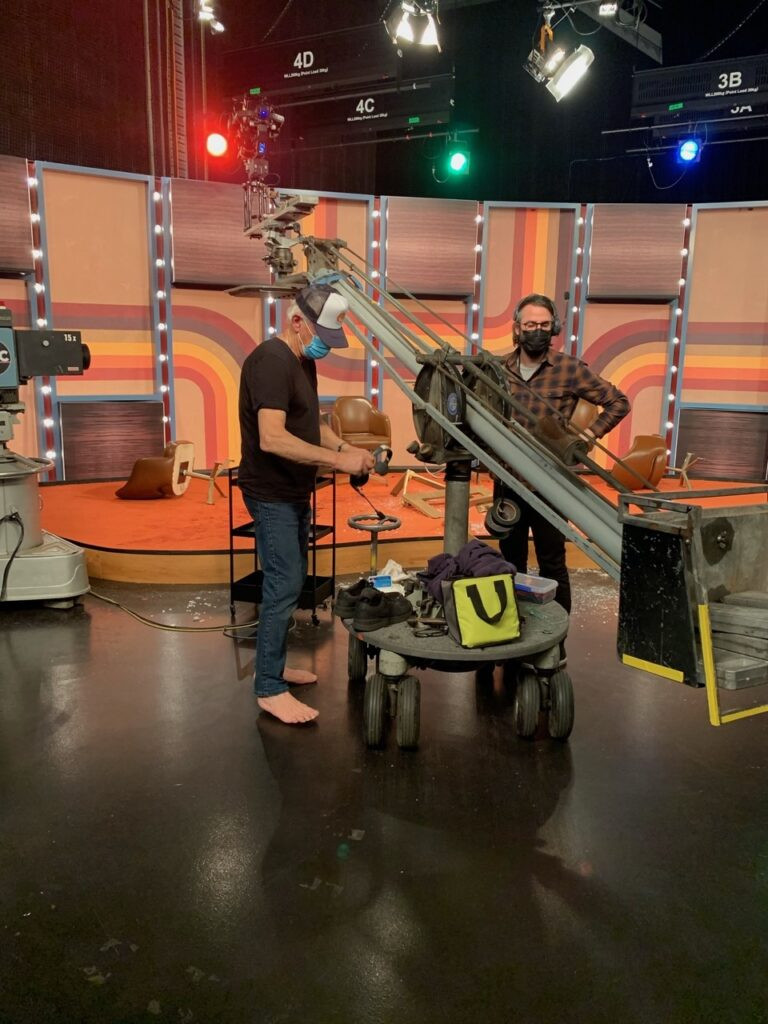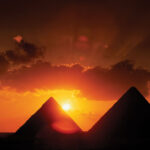Critically acclaimed and chillingly unique, Late Night with the Devil has captivated audiences with its found-footage horror premise set within a 1970s late-night talk show. For those eager to experience this retro horror for themselves, the burning question is: where to watch Late Night with the Devil? As of its release, you can find Late Night with the Devil streaming on Shudder, with potential availability for rental or purchase on various digital platforms. Check your preferred streaming service for the most up-to-date availability in your region.
Beyond its gripping narrative and stellar performances, a significant part of Late Night with the Devil‘s allure lies in its meticulously crafted aesthetic, transporting viewers directly back to the era of 1970s television. To achieve this authentic look, cinematographer Matthew Temple employed a range of techniques, from vintage lighting to period-accurate camera operation. In this article, we delve into the secrets behind the film’s visual style, drawing insights from an exclusive interview with Temple himself, originally published in Filmmaker Magazine. Discover how Late Night with the Devil masterfully blends horror with a retro TV vibe, and find out exactly where to watch this must-see movie.
Recreating the 1970s Television Aesthetic
Found footage horror often grapples with believability. Why would characters continue filming amidst terrifying events? Late Night with the Devil cleverly sidesteps this issue with its premise. Presented as the “master tapes” of a 1977 Halloween night broadcast, the film justifies the constant camera presence. This setup immediately immerses the audience in the era, demanding a visual style that authentically reflects 1970s television.
Directors Colin and Cameron Cairnes provided Matthew Temple with a rich visual library of 1970s talk shows, including both American and Australian examples like the Don Lane Show. Temple absorbed these references, aiming to distill the essence of these programs. The goal wasn’t just to mimic the look, but to understand the underlying elements that made those shows feel distinctly “1970s TV.” This deep dive into archival footage was crucial in shaping the film’s visual language and ensuring that audiences would truly believe they were watching rediscovered tapes from that era.
Camera and Lens Choices for Authenticity
One of the key decisions Temple faced was the choice of camera and lenses. While the directors briefly considered using period cameras for ultimate authenticity, the practicalities and technical requirements of modern filmmaking intervened. The need for a 4K deliverable quickly ruled out vintage studio cameras.
Instead, Temple opted for the Sony Venice, shooting in 4K with a Super 35 sensor. This choice was deliberate. According to Temple, “Shooting 6K or 8K with a large sensor would have played directly against what I was trying to achieve.” Large format sensors, common in contemporary filmmaking, would have created a shallow depth of field and a field of view that felt distinctly modern, clashing with the intended 1970s TV aesthetic. The Super 35 sensor, in contrast, helped emulate the look of older 2/3” tube cameras, which were standard in television studios of the time.
 Director of photography Matthew Temple, B cam operator Alex Dupen and A camera operator Rayner Cook on the set of Late Night with the Devil
Director of photography Matthew Temple, B cam operator Alex Dupen and A camera operator Rayner Cook on the set of Late Night with the Devil
Image alt text: Behind the scenes of Late Night with the Devil movie set, featuring director of photography Matthew Temple with camera operators Alex Dupen and Rayner Cook, highlighting the film’s commitment to authentic 1970s TV production techniques.
To further enhance the period feel, Fujinon zoom lenses were used. Temple initially considered vintage lenses, but finding three matching sets in good condition proved too challenging. Modern lenses offered reliability and performance, while the vintage aesthetic was ultimately achieved through a combination of camera operation, lighting, and post-production techniques. Crucially, Temple and his camera operators took on the roles of 1970s studio cameramen, operating the pedestals, pulling their own focus, and controlling the zooms themselves. This hands-on approach was vital for capturing the authentic feel of a live 1970s television broadcast, avoiding the overly polished look of modern, highly crewed productions.
Lighting Like It’s 1977
Lighting played a crucial role in recreating the 1970s TV studio environment. Temple and his gaffer, Matt Begg, scoured lighting rental houses for vintage tungsten units. These older lights, often dusted off after years of disuse, became essential tools in crafting the film’s visual texture. Units like zip lights and ground rows, reminiscent of the era, provided a softer, warmer light quality that differed significantly from modern LED fixtures.
Temple explained, “Finding these old tungsten lights was just like finding gold: ‘Wow! Look at these zip lights! They’re going to be beautiful soft lights. These ground rows are going to be great for the background.’” The choice of these lights wasn’t purely aesthetic; Temple also knew that these vintage fixtures would be visible in some shots, further enhancing the on-screen authenticity. The iconic purple-ish hue of older Mole-Richardson units also contributed to the period-accurate lighting design. Gels were used sparingly, maintaining a largely neutral color palette, typical of 1970s television broadcasts. Par cans were subtly gelled to add depth and visual interest, reflected off the studio floor in wider shots. Behind the stage, vertical fluorescent lights, gelled with a specific blue, created a distinct separation from the studio walls, adding another layer of visual authenticity.
The Crane and Studio Setup
The set itself, built within a Melbourne soundstage, was meticulously designed by production designer Otello Stolfo. While the soundstage offered a basic infrastructure, including an overhead grid for lighting, the entire studio set, including audience seating, was custom-built to replicate a 1970s TV studio.
Adding to the period authenticity was the use of a 1970s crane. Discovered in the warehouse of key grip Dean Garro, the crane, with its original paint and a touch of “instability,” was perfect for the job. Temple noted that it provided “just the right amount of instability to give the camera a little bit of a wiggle as it’s going in on a crane shot, just like I’d observed in the YouTube videos [of 1970s-era talk shows].” This subtle movement, characteristic of older camera equipment, further enhanced the vintage feel. The crane was operated without tracks, wheeled directly on the studio floor, sometimes requiring key grip Tony Hall to remove his shoes for better traction on the talcum powder-covered surface, ensuring smooth, period-accurate crane shots.
 Key grip Tony Hall and 2nd AC Matt Wilson with the period correct crane used in Late Night with the Devil
Key grip Tony Hall and 2nd AC Matt Wilson with the period correct crane used in Late Night with the Devil
Image alt text: Key grip Tony Hall and 2nd AC Matt Wilson pictured with a vintage 1970s camera crane on the set of Late Night with the Devil, emphasizing the production’s dedication to historical accuracy in equipment and filming techniques.
Post-Production Magic: Grading and VFX
While in-camera techniques were crucial, post-production played an equally significant role in achieving the final 1970s TV look. Color grader Nicholas Hower of Post Lab IO was instrumental in this process, focusing on the nuances of vintage video aesthetics. Hower’s approach went beyond simply adding grain. He meticulously layered effects like chromatic aberration, lens distortion, color range clamping, and misaligned RGB channels to replicate the imperfections and characteristics of 1970s studio cameras. Temple praised Hower’s “deep dive” into video aesthetics, noting that his “obsession” truly elevated the film’s visual style.
Initially, the behind-the-scenes documentary footage was planned in color with a LUT designed to emulate a vibrant color film stock. However, during editing, directors Colin and Cameron Cairnes decided to convert this footage to black and white to create a clearer visual distinction from the studio broadcast segments. This black and white look, based on a Fuji black and white stock with added grain, was a post-production decision that ultimately enhanced the film’s overall aesthetic and storytelling. While Temple initially found the black and white choice surprising, he acknowledged it as “totally the right choice” in achieving the desired contrast and period feel.
Operating Like a 70s Cameraman
Beyond equipment and lighting, camera operation was key to capturing the authentic feel of a 1970s talk show. Temple, who began his career as a studio camera operator, led by example, training his two experienced camera operators, Alex Dupen and Rayner Cook, in the specific techniques of the era. The emphasis was on central framing, a stark contrast to modern cinematic compositions that often utilize negative space and leading room. Temple instructed his operators to frame close-ups “like a balloon,” filling the 4:3 aspect ratio frame with the subject’s head.
To reinforce the desired aesthetic, Temple jokingly told his operators that a “terrible shot” would be considered a compliment, signifying they were successfully capturing the awkward, often less refined compositions of 1970s television. He meticulously studied 1970s talk show footage, pausing and analyzing camera positions and movements. A strict rule was implemented: camera movements had to be physically possible within the timeframe of a live broadcast. “If an operator couldn’t physically get the camera from one spot to another and reframe it in [the amount of real time that would’ve elapsed], then that shot was illegal,” Temple explained. Furthermore, a deeper stop of around T4 was used to replicate the depth of field common in 1970s studio productions, moving away from the shallow depth of field often favored in contemporary drama.
Where to Stream Late Night with the Devil
After exploring the intricate details of its 1970s television recreation, the question remains: where can you watch Late Night with the Devil and witness these visual techniques in action? Currently, Late Night with the Devil is available for streaming on Shudder. Shudder is a streaming service specializing in horror, thriller, and suspense content, making it the perfect home for this unique film. For viewers in regions where Shudder is not directly accessible, or for those who prefer other platforms, Late Night with the Devil may also be available for rent or purchase through digital retailers such as Amazon Prime Video, Apple TV, Google Play, and Vudu. Availability can vary by region, so be sure to check your local streaming and digital storefronts for the most accurate and up-to-date information on where to watch Late Night with the Devil in your area.
Conclusion
Late Night with the Devil is more than just a horror film; it’s a masterclass in recreating a specific visual era. Through meticulous attention to detail in cinematography, lighting, set design, and post-production, Matthew Temple and his team have successfully transported audiences back to the golden age of 1970s television. The film’s critical acclaim and audience reception are a testament to the effectiveness of these techniques in creating a truly immersive and unsettling viewing experience. Now knowing where to watch Late Night with the Devil, don’t miss the opportunity to experience this unique and visually stunning horror film and appreciate the artistry behind its retro television aesthetic. Check Shudder and your preferred digital platforms to stream or rent Late Night with the Devil today.

